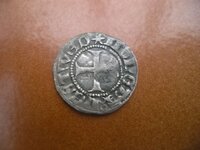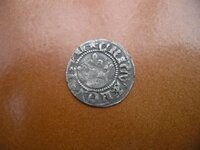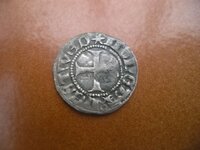woody50
Bronze Member
- Jun 21, 2007
- 1,879
- 203
- Detector(s) used
- XP Deus
- Primary Interest:
- All Treasure Hunting
I have finally started to photography my silver coins today, could not finish because the sun disappeared. These tiny silver coins were found in Germany close to the border with Holland, they were quite deep, and only found because they were together in a bunch. If they had been scattered they would have not been found. The dime is shown for sizing.
Here is
1) a description of the coins,
2) a description of what a Denier is,
3) a short history of the Hungarian Kings including the blind King Béla II follows.
1) 21 Hongaarse deniers from King Béla II (1131-1141)
Material: silver
Diameter: between 9.8 mm to 12.0 mm
Mass: between 0.2 and 0.55 grams
Reverse: A smooth inner concentric circle containing a type of Maltese Cross, in each quadrant a triangle symbol.
A smooth outer circle has one plus (+) symbol, one equal (=) symbol and 6 minus (-) symbols
Obverse: A outer circle with many radial bars, in the inside of the circle a Cross, the legs of which are created with pebbled symbols. In each quadrant of the Cross are three pellets, two joined by a curved moon like slice, and another pellet located at the highest point of the curve. In the concave part of the slice, are 4 different small Cross symbols, 1x Maltese Cross, 1x Greek Cross, 1x another type of Maltese Cross, 1x maybe a Formee Patte Cross.
(Since I am not sure about the crosses and description above. If you can help determine the correct description I would appreciate
any additional information or corrections.)
2) A Denier
What is a denier? The denier was a French coin created in the Early Middle Ages. It was introduced together with an accounting system in which twelve deniers equaled one sou and twenty sous equalled one livre.
This system and the denier itself served as the model for many of Europe's currencies, including the British pound, Italian lira, Spanish dinero and the Portuguese dinheiro.
The name denier was derived from the name of the Roman coin the denarius.
The British equivalent of the denier was the penny, 240 of which (prior to decimalisation) made up one British pound or 20 shillings. The symbol for both the old denier and, until recently, the penny used in the United Kingdom and elsewhere was "d".
3) Hungarian History and some of it's Kings
Hungary is one of the oldest countries in Europe. It was settled in 896, before France and Germany became separate countries, and before the Anglo-Saxon kingdoms unified. Medieval Hungary controlled more territory than medieval France, and the population of medieval Hungary was the third largest of any country in Europe.
The history of the Kingdom of Hungry had many Kings, who did much to try to insure their own son would ascend the crown after them.
King Béla II was a blind King, he and his father were intentionally blinded by his Uncle King Colman to keep them off the thrown. Want to know more? How did the Blind Béla II gain the thrown?
Then read this summary of the Kings of Hungary in the Arpad dynasty. It is quite long but interesting. Mostly condensed out information from the internet. See also the 'family tree' to better understand all the Kings relationships.
Kingdom of Hungary the Árpád dynasty
11th Century
In the 11th century the Grand Prince Stephen was crowned King in 1001, the first King of Hungary (1000–1038) and he was the founder of the state. When his son died he had his sisters son Peter Orseolo named as his heir which resulted in a conspiracy lead by his cousin, Vazul, who had been living imprisoned outside Hungary. But Vazul was blinded on King Stephen's orders and his three sons (Levente, Andrew and Béla) were exiled to insure that Orselo was king after his death.
When King Stephen I died in 1038, King Peter Orseolo ascended the throne but he had
to struggle with King Stephen's brother-in-law, Samuel Aba who was later named King Aba (1041-1044). King Peter ruled again from 1044 to 1046 but ended when an extensive revolt of the pagan Hungarians broke out and he was captured by them. King Aba (1046-1049) then ruled for just 3 years.
Then Duke Vazul's son, Andrew, who had been living in exile seized the power and he was crowned, King Andrew I (1046-1060). He restored the position of Christianity in the kingdom. In 1048, King Andrew invited his younger brother, Béla to the kingdom and conceded one-third of the counties of the kingdom rightfully to him (Duke Béla).
King Andrew I was the first king who had his son, Solomon (1063-1074) crowned during his life in order to ensure his son's succession to the throne. But he was not able to overcome the tradition of seniority of Kings, and his blind brother, King Béla I (1060-1063) acquired the throne instead of the young Solomon. After King Béla I, King Solomon (1057-1080) and his cousins, Géza, Ladislaus and Lampert governed the land. Then Duke Géza rebelled against his cousin Solomon and in 1074 and was proclaimed King (1074-1077). When King Géza I died in 1077 his partisans, disregarding his young sons, proclaimed his brother, Ladislaus king.
King Ladislaus I (1077-1095) managed to persuade King Solomon, who had been ruling in some western counties,
to abdicate the throne. During his reign, the Kingdom of Hungary expanded and ruled the Kingdom of Croatia (1091). He entrusted the government of the newly occupied kingdom to his younger nephew, Álmos.
When King Ladislaus I died, his elder nephew, King Coloman was proclaimed king (1095-1116). King Coloman defeated Petar Svačić who had been proclaimed king of Croatia in 1097 and thus he annexed the neighboring kingdom to the
Kingdom of Hungary; henceforward, the kings of Hungary were also kings of Croatia and the two kingdoms formed a political union.
12th Century
In the 12th century King Coloman deprived his brother, Álmos of his duchy in 1107. He caught his second wife, Eufemia of Kiev in adultery; therefore, she was divorced and sent back to Kiev around 1114. Eufemia bore a son, named Boris in Kiev, but King Coloman refused to accept him as his son.
At around 1115 King Coloman had Duke Álmos and his son (Duke Béla) blinded in order to ensure the succession of his own son, King Stephen II (1116-1131). Because King Stephen II did not father any son, his sister's son, Saul was proclaimed heir to his throne instead of the blind Duke Béla.
Nevertheless, when King Stephen II died (March 1, 1131), his blind cousin Béla managed to acquire the throne. King Béla II (1131-1141) strengthened his rule by defeating King Coloman's alleged son, Boris who endeavoured to deprive him of the throne with foreign military assistance. King Béla II occupied some territories in Bosnia and he conceded the new territory to his younger son, Ladislaus. Henceforward, members of the Árpád dynasty governed Slavonia, Croatia and Transylvania.
After King Béla II and King Géza II (1141-1162), King Geza's son Stephen III (1162-1172) had to struggle for his throne with his uncles, Kings Ladislaus II (1162-1163) and color=purple] Stephen IV[/color] (1163-1165) who rebelled against him with the assistance of the Byzantine Empire.
Here is
1) a description of the coins,
2) a description of what a Denier is,
3) a short history of the Hungarian Kings including the blind King Béla II follows.
1) 21 Hongaarse deniers from King Béla II (1131-1141)
Material: silver
Diameter: between 9.8 mm to 12.0 mm
Mass: between 0.2 and 0.55 grams
Reverse: A smooth inner concentric circle containing a type of Maltese Cross, in each quadrant a triangle symbol.
A smooth outer circle has one plus (+) symbol, one equal (=) symbol and 6 minus (-) symbols
Obverse: A outer circle with many radial bars, in the inside of the circle a Cross, the legs of which are created with pebbled symbols. In each quadrant of the Cross are three pellets, two joined by a curved moon like slice, and another pellet located at the highest point of the curve. In the concave part of the slice, are 4 different small Cross symbols, 1x Maltese Cross, 1x Greek Cross, 1x another type of Maltese Cross, 1x maybe a Formee Patte Cross.
(Since I am not sure about the crosses and description above. If you can help determine the correct description I would appreciate
any additional information or corrections.)
2) A Denier
What is a denier? The denier was a French coin created in the Early Middle Ages. It was introduced together with an accounting system in which twelve deniers equaled one sou and twenty sous equalled one livre.
This system and the denier itself served as the model for many of Europe's currencies, including the British pound, Italian lira, Spanish dinero and the Portuguese dinheiro.
The name denier was derived from the name of the Roman coin the denarius.
The British equivalent of the denier was the penny, 240 of which (prior to decimalisation) made up one British pound or 20 shillings. The symbol for both the old denier and, until recently, the penny used in the United Kingdom and elsewhere was "d".
3) Hungarian History and some of it's Kings
Hungary is one of the oldest countries in Europe. It was settled in 896, before France and Germany became separate countries, and before the Anglo-Saxon kingdoms unified. Medieval Hungary controlled more territory than medieval France, and the population of medieval Hungary was the third largest of any country in Europe.
The history of the Kingdom of Hungry had many Kings, who did much to try to insure their own son would ascend the crown after them.
King Béla II was a blind King, he and his father were intentionally blinded by his Uncle King Colman to keep them off the thrown. Want to know more? How did the Blind Béla II gain the thrown?
Then read this summary of the Kings of Hungary in the Arpad dynasty. It is quite long but interesting. Mostly condensed out information from the internet. See also the 'family tree' to better understand all the Kings relationships.
Kingdom of Hungary the Árpád dynasty
11th Century
In the 11th century the Grand Prince Stephen was crowned King in 1001, the first King of Hungary (1000–1038) and he was the founder of the state. When his son died he had his sisters son Peter Orseolo named as his heir which resulted in a conspiracy lead by his cousin, Vazul, who had been living imprisoned outside Hungary. But Vazul was blinded on King Stephen's orders and his three sons (Levente, Andrew and Béla) were exiled to insure that Orselo was king after his death.
When King Stephen I died in 1038, King Peter Orseolo ascended the throne but he had
to struggle with King Stephen's brother-in-law, Samuel Aba who was later named King Aba (1041-1044). King Peter ruled again from 1044 to 1046 but ended when an extensive revolt of the pagan Hungarians broke out and he was captured by them. King Aba (1046-1049) then ruled for just 3 years.
Then Duke Vazul's son, Andrew, who had been living in exile seized the power and he was crowned, King Andrew I (1046-1060). He restored the position of Christianity in the kingdom. In 1048, King Andrew invited his younger brother, Béla to the kingdom and conceded one-third of the counties of the kingdom rightfully to him (Duke Béla).
King Andrew I was the first king who had his son, Solomon (1063-1074) crowned during his life in order to ensure his son's succession to the throne. But he was not able to overcome the tradition of seniority of Kings, and his blind brother, King Béla I (1060-1063) acquired the throne instead of the young Solomon. After King Béla I, King Solomon (1057-1080) and his cousins, Géza, Ladislaus and Lampert governed the land. Then Duke Géza rebelled against his cousin Solomon and in 1074 and was proclaimed King (1074-1077). When King Géza I died in 1077 his partisans, disregarding his young sons, proclaimed his brother, Ladislaus king.
King Ladislaus I (1077-1095) managed to persuade King Solomon, who had been ruling in some western counties,
to abdicate the throne. During his reign, the Kingdom of Hungary expanded and ruled the Kingdom of Croatia (1091). He entrusted the government of the newly occupied kingdom to his younger nephew, Álmos.
When King Ladislaus I died, his elder nephew, King Coloman was proclaimed king (1095-1116). King Coloman defeated Petar Svačić who had been proclaimed king of Croatia in 1097 and thus he annexed the neighboring kingdom to the
Kingdom of Hungary; henceforward, the kings of Hungary were also kings of Croatia and the two kingdoms formed a political union.
12th Century
In the 12th century King Coloman deprived his brother, Álmos of his duchy in 1107. He caught his second wife, Eufemia of Kiev in adultery; therefore, she was divorced and sent back to Kiev around 1114. Eufemia bore a son, named Boris in Kiev, but King Coloman refused to accept him as his son.
At around 1115 King Coloman had Duke Álmos and his son (Duke Béla) blinded in order to ensure the succession of his own son, King Stephen II (1116-1131). Because King Stephen II did not father any son, his sister's son, Saul was proclaimed heir to his throne instead of the blind Duke Béla.
Nevertheless, when King Stephen II died (March 1, 1131), his blind cousin Béla managed to acquire the throne. King Béla II (1131-1141) strengthened his rule by defeating King Coloman's alleged son, Boris who endeavoured to deprive him of the throne with foreign military assistance. King Béla II occupied some territories in Bosnia and he conceded the new territory to his younger son, Ladislaus. Henceforward, members of the Árpád dynasty governed Slavonia, Croatia and Transylvania.
After King Béla II and King Géza II (1141-1162), King Geza's son Stephen III (1162-1172) had to struggle for his throne with his uncles, Kings Ladislaus II (1162-1163) and color=purple] Stephen IV[/color] (1163-1165) who rebelled against him with the assistance of the Byzantine Empire.
Amazon Forum Fav 👍
Attachments
Upvote
0


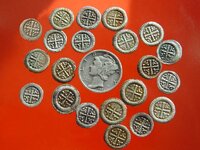
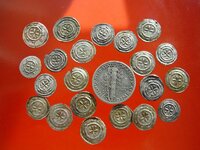

 You'll have to fill me in. As for the bag is it a body bag?
You'll have to fill me in. As for the bag is it a body bag?  The only time I took soil home was when I had just discovered a cache of fur trade seed beads and also noticed a violent storm approaching fast so filled a few bags with dirt and high tailed it out of there. (I ended up getting hailed on anyway) at home I sifted over 500 blue seed beads from the late 1700's. Please fill me in on these things, as I am extremely interested in how our European friends treasure hunt and what your version of a "privey pit", refuse pit, midden or cache is.
The only time I took soil home was when I had just discovered a cache of fur trade seed beads and also noticed a violent storm approaching fast so filled a few bags with dirt and high tailed it out of there. (I ended up getting hailed on anyway) at home I sifted over 500 blue seed beads from the late 1700's. Please fill me in on these things, as I am extremely interested in how our European friends treasure hunt and what your version of a "privey pit", refuse pit, midden or cache is.









